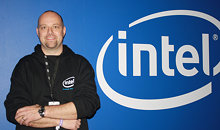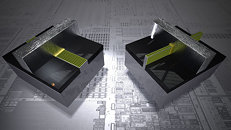Monday, December 5th 2011

Intel Has 14 nm Test Circuits In The Lab, Limited Teaser Info Released
Nordic Hardware has scored an exclusive interview with Pat Bliemer, Managing Director of Intel Northern Europe to discuss the technology following on from the 22 nm one used in the upcoming Ivy Bridge processors. Unfortunately, Bliemer was light on the technical details of this technology and didn't say when it would see the light of day, except to say that it will make fuller use of the Tri-Gate tech being used in the Ivy Bridge processors and that test circuits are running.
We need to keep going and you can trust me that in our labs we actually have the next generation after 22nm running, so we need to keep going.[...]I cannot really disclose more about that other than that in a laboratory-environment, absolutely we do have the path, our engineers do have the path to actually go and produce 14nm products. There are many variables that you can play with of course it is not the right name for it and the engineers would not like it when I say play, that you can influence to actually go and stay to that model. And I think the breakthrough we had now with the 3D metal gates, just the design of the gate will actually allow for much more efficient thermals and power.Back in July, we looked even further ahead and reported that Intel aims to have 10 nm-based processors by 2018 and that the 14 nm tech is due for release around 2014. Watch this space.


39 Comments on Intel Has 14 nm Test Circuits In The Lab, Limited Teaser Info Released
lol
14nm = potentially packing double he amount of transistors that AMD can in the same amount of space ( based on AMDs 2014 road map)
3d transistors are much more power effciant they have much lower voltage leak and can because of this can do higher clocks at lower voltage.
That means over-clocking monsters as heat shouldn't be a problem.*
* There will still be heat, but there will be far less of it
That or make a breakthrough in optic computing or graphene chips lolWith this much of an architectural edge even intels crappy GPU technology would be able to match AMDs if not beat it. ( so intel will be able to beat AMD at their own game)
No wonder AMD are going mobile :laugh:
:cry:
Also www.techpowerup.com/forums/showthread.php?t=155920 I don't think AMD are planning on trying.
As a partner in the Joint Development Alliance (JDA) centered around IBM, GlobalFoundries has access to over a decade of research in finFET technology and can choose to use it when it may be needed. The JDA’s collaborative decision to continue with 2D planer structures in 20nm was based on the power, performance, and cost parameters that drive the specifications for the global industry, from high performance desktop computing to low power mobile applications.
And a little info on FinFETs.
At this pace, Skynet will be online soon.
Plus, I'll believe it when I see it. Intels mindset is to throw enough x86 at it to surpass the weakness. Real GPU cores are much more advanced. Until Intel changes that mindset, it is foolish to think they'll produce a competitive GPU.
PS. This PR is a bit of scare mongering too I think. I doubt Intel will go straight to 14nm. It is two jumps from 22nm. I expect 16nm or 18nm first.
Intel with this 'news' to AMD: :nutkick: Gotta love tech though, eh? :rockout:
IB (22nm) - 2012
Haswell (14nm) - 2014
Broadwell (10nm) - 2018
We're going to be stuck with Ivy Bridge for two whole years?
We're going to be stuck with Haswell for FOUR YEARS?!
Sandy Bridge (32 nm, 2011) -> Ivy Bridge (22 nm, 2012).
Haswell (22 nm, 2013) -> Broadwell (14 nm, 2014).
Skylake (14 nm, 2015) -> Skymont (10 nm, 2016).
Intel source [PDF]. This, of course, may be subject to change with revised roadmaps.
And as for your comment about dead in the water! How the hell do you know what amd's plans are going to be? Are you an actual reporter? Oh I forgot you get your info on the interweb my bad. :shadedshu